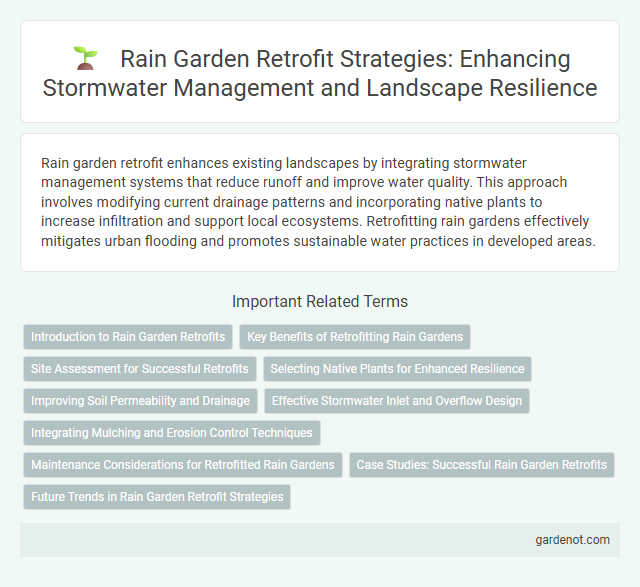Rain garden retrofit enhances existing landscapes by integrating stormwater management systems that reduce runoff and improve water quality. This approach involves modifying current drainage patterns and incorporating native plants to increase infiltration and support local ecosystems. Retrofitting rain gardens effectively mitigates urban flooding and promotes sustainable water practices in developed areas.
Introduction to Rain Garden Retrofits
Rain garden retrofits enhance existing landscapes by integrating sustainable stormwater management solutions that reduce runoff and improve water quality. These retrofits utilize native plants and engineered soil media to capture and filter rainwater, thereby decreasing pollution and mitigating urban flooding. Implementing rain garden retrofits supports ecosystem services while promoting groundwater recharge in developed areas.
Key Benefits of Retrofitting Rain Gardens
Retrofitting rain gardens enhances stormwater management by increasing water infiltration and reducing runoff, which helps prevent flooding and erosion. These upgrades improve biodiversity by creating habitat for native plants and pollinators, contributing to urban ecological health. Enhanced rain gardens also promote groundwater recharge and improve water quality by filtering pollutants, supporting sustainable urban water systems.
Site Assessment for Successful Retrofits
Site assessment for rain garden retrofits involves evaluating soil permeability, existing drainage patterns, and vegetation to ensure effective stormwater management. Identifying potential constraints such as underground utilities, slope stability, and groundwater levels is critical for optimal garden placement and design. Thorough site analysis enhances water infiltration, reduces runoff, and maximizes pollutant removal in retrofit projects.
Selecting Native Plants for Enhanced Resilience
Selecting native plants for rain garden retrofit enhances resilience by improving water absorption and supporting local biodiversity. Native species such as switchgrass, joe-pye weed, and blue flag iris thrive in fluctuating moisture conditions, reducing maintenance and increasing drought tolerance. Incorporating deep-rooted perennials stabilizes soil and boosts pollutant filtration, optimizing rain garden performance.
Improving Soil Permeability and Drainage
Rain garden retrofits enhance soil permeability and drainage by incorporating amended soil mixes rich in sand and organic matter, which facilitate rapid water infiltration and reduce surface runoff. Installing subsurface drainage layers and ensuring proper grading further optimize water flow through the garden, preventing waterlogging and promoting healthy plant growth. These improvements lead to more efficient stormwater management, minimizing urban flooding and contributing to groundwater recharge.
Effective Stormwater Inlet and Overflow Design
Effective stormwater inlet and overflow design in rain garden retrofits maximizes water capture and prevents flooding by ensuring controlled water flow during heavy rainfall. Incorporating appropriately sized inlet structures with sediment filters enhances pollutant removal, while well-designed overflow paths direct excess water safely to avoid erosion and landscape damage. Optimizing these components increases rain garden efficiency and longevity in urban stormwater management systems.
Integrating Mulching and Erosion Control Techniques
Rain garden retrofit projects benefit from integrating mulching and erosion control techniques, which enhance soil stability and moisture retention. Applying organic mulch layers reduces surface runoff and prevents soil erosion by cushioning the impact of raindrops and promoting infiltration. Combining erosion control blankets or mats with mulching can further secure slopes and protect young plant roots during the establishment phase, ensuring long-term rain garden functionality and resilience.
Maintenance Considerations for Retrofitted Rain Gardens
Retrofitted rain gardens require consistent maintenance to ensure optimal performance, including regular inspection for sediment buildup, erosion, and clogged inlets. Seasonal tasks such as removing invasive weeds, replenishing mulch, and inspecting plant health promote pollutant filtration and water infiltration. Proper maintenance preserves the retrofit's stormwater management capacity, enhances biodiversity, and extends the rain garden's functional lifespan.
Case Studies: Successful Rain Garden Retrofits
Rain garden retrofits have demonstrated significant success in urban stormwater management, as evidenced by multiple case studies in cities like Portland, Oregon, and Philadelphia, Pennsylvania, where retrofitted rain gardens reduced runoff by up to 40%. These projects often utilize native plants and biofiltration techniques to enhance pollutant removal and improve local biodiversity. Monitoring data from retrofitted sites show improved infiltration rates and decreased combined sewer overflow events, highlighting rain gardens' effectiveness in sustainable urban drainage systems.
Future Trends in Rain Garden Retrofit Strategies
Emerging future trends in rain garden retrofit strategies emphasize integrating smart sensor technology to monitor soil moisture and optimize water absorption efficiency. Advanced biofiltration materials and native plant selections are increasingly used to enhance pollutant removal and support local biodiversity. Modular and scalable design approaches allow for flexible implementation in urban environments, improving stormwater management adaptability.
Rain garden retrofit Infographic

 gardenot.com
gardenot.com